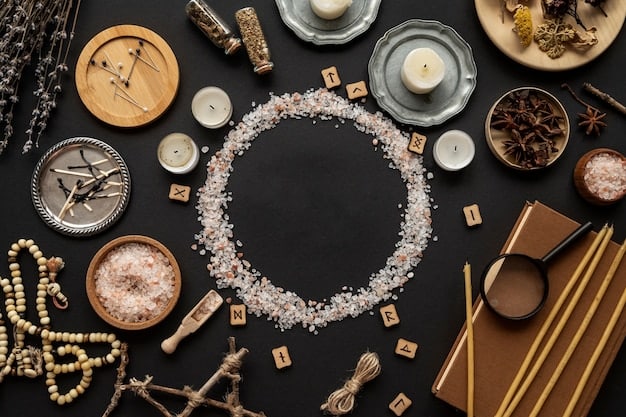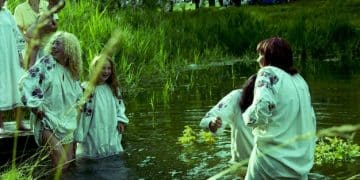The Book of Shadows: A Comprehensive Guide to BOS Templates and Uses

The Book of Shadows (BOS) is a witch’s personal journal, serving as a repository for spells, rituals, observations, and insights; this comprehensive review explores various BOS templates, providing guidance on their uses and offering inspiration for practitioners seeking to create a meaningful and effective BOS.
The Book of Shadows: A Comprehensive Review of Different BOS Templates and Their Uses is more than just a journal; it’s a living document that reflects your spiritual journey. Let’s explore the diverse templates and methodologies for creating your own powerful Book of Shadows.
Understanding the Essence of a Book of Shadows
The Book of Shadows (BOS) is a cornerstone in many Wiccan and Pagan traditions. It serves as a personal repository for spells, rituals, herbal knowledge, divination methods, and spiritual insights. But what exactly makes a Book of Shadows so important?
A well-crafted BOS is a reflection of the practitioner’s journey, evolving alongside their experiences and deepening their understanding. It’s a place to record successes, analyze failures, and refine one’s craft.
The Historical Context
The modern concept of the Book of Shadows is largely attributed to Gerald Gardner, often referred to as the “father” of Wicca. His BOS, allegedly passed down through generations, became the template for many subsequent versions. While the historicity of Gardner’s claim is debated, the BOS’s significance within Wicca is undeniable.
Key Components of a Book of Shadows
While the exact contents vary, most Books of Shadows include:
- Spells: Detailed instructions for spellcasting, including ingredients, timing, and incantations.
- Rituals: Outlines for seasonal celebrations (Sabbats), Esbaths, and other important ceremonies.
- Herbal Knowledge: Information about the magical and medicinal properties of herbs.
- Divination: Records of tarot readings, scrying sessions, or other divination practices.
- Personal Reflections: Journal entries documenting spiritual experiences, dreams, and insights.

The Book of Shadows should be a living document, constantly updated and refined. It’s a testament to your dedication and growth as a practitioner of the craft.
Choosing the Right BOS Template for You
There’s no one-size-fits-all approach to creating a Book of Shadows. The ideal template depends on your personal preferences, tradition, and specific goals. Let’s explore some popular options.
Consider your personal style and how you plan to use your BOS. Do you prefer a structured format or a more free-flowing approach?
The Traditional Gardnerian Template
This template follows the structure popularized by Gerald Gardner. It typically includes:
- Invocation of the God and Goddess
- The Wiccan Rede
- Rituals for Sabbats and Esbaths
- Initiation Rites
This template is best suited for those who follow traditional Wiccan paths and value adherence to established practices.
The Eclectic Template
An eclectic template allows for greater flexibility and personalization. It can incorporate elements from various traditions, including:
- Spells from different cultures
- Herbal remedies from various sources
- Personal rituals and practices
This template is ideal for practitioners who draw inspiration from diverse sources and prefer a more personalized approach.

Choosing the right template is a crucial first step in creating a Book of Shadows that truly resonates with you and supports your magical journey.
Organizing Your Book of Shadows: Practical Tips
Once you’ve chosen a template, it’s time to focus on organization. A well-organized BOS makes it easier to find information and track your progress.
Consider using dividers, tabs, or a color-coding system to categorize your entries. This will save you time and frustration in the long run.
Creating a Table of Contents
A table of contents is essential for navigating your BOS efficiently. Update it regularly as you add new entries.
Using a Numbering System
Numbering each page or section helps with referencing and cross-referencing information. It also makes it easier to create an index.
Digital vs. Physical Book of Shadows
While a physical book has a certain charm, a digital BOS offers convenience and portability. Consider the pros and cons of each:
- Physical: Tangible, personal connection, less prone to technological issues.
- Digital: Easy to search, back up, and update, accessible from various devices.
Ultimately, the best organization method depends on your individual preferences and how you intend to use your Book of Shadows.
Effective organization is a key element in ensuring that your Book of Shadows will serve you well.
Customizing Your Book of Shadows with Creativity and Flair
Your Book of Shadows is a personal reflection of your practice, so infuse it with your unique creativity. Don’t be afraid to experiment with different layouts, fonts, and illustrations.
Adding your own personal touch can transform your BOS from a mere collection of information into a cherished and powerful tool.
Adding Illustrations and Drawings
Visual elements can enhance your understanding and connection to the material. Include:
- Drawings of deities and symbols
- Illustrations of herbs and crystals
- Diagrams of rituals and spells
Using Calligraphy and Decorative Fonts
Experiment with different fonts and calligraphy styles to create a visually appealing BOS. This can make your entries more engaging and memorable.
Incorporating Personal Symbolism
Reflect the symbols and images that resonate on your spiritual path.
Personalizing your BOS can make it a powerful tool for reflection and growth.
Ethical Considerations for Your Book of Shadows
As you fill your Book of Shadows, it’s essential to consider the ethical implications of your practices. This includes respecting the beliefs and traditions of others, avoiding harm, and using your power responsibly.
Ethical practice builds trust with spirits and strengthens your magical work.
Respecting Cultural Appropriation
Be mindful of cultural appropriation when incorporating elements from other traditions. Do thorough research and give credit where it is due.
Avoiding Harmful Spells
Focus on spells that promote healing, growth, and well-being. Avoid spells that could cause harm to yourself or others.
Ethical considerations keep magic responsible and powerful.
Protecting and Preserving Your Book of Shadows
Your Book of Shadows is a valuable tool, so protect it from physical and energetic harm. Store it in a safe place and cleanse it regularly.
Physical and energetic protection preserve the BOS’s power over time.
Physical Protection
Store your BOS in a waterproof container. Keep it away from direct sunlight and extreme temperatures.
Energetic Cleansing
Cleanse your BOS regularly with sage, incense, or sound. Visualize it filled with light and positive energy.
Protecting your BOS ensures its vitality.
| Key Point | Brief Description |
|---|---|
| 🌱 Herbal Knowledge | Includes information about the magical and medicinal properties of herbs. |
| ✨ Personal Reflections | Contains journal entries documenting spiritual experiences and dreams. |
| 🛡️ Ethical Practice | Respect cultural appropriation. |
| 🔮 Divination Methods | Includes guidance to tarot readings. |
Frequently Asked Questions (FAQ)
▼
The primary purpose is to serve as a repository for recording spells, rituals, and magical knowledge accumulated by a practitioner. It helps document spiritual growth and experiences.
▼
A Book of Shadows can be either digital or physical. The choice depends on personal preference, accessibility, and practicality for the practitioner. Both formats have their advantages.
▼
You should update your Book of Shadows as frequently as needed, ideally after conducting a ritual, learning new information, or experiencing a significant spiritual event. Regular updates keep its content relevant.
▼
Some essential tools used in witchcraft practice include candles for setting intentions, crystals for energy work, tarot cards for divination, herbs for spell work, and a Book of Shadows for recording your work.
▼
Important ethical considerations include respecting the free will of others, not causing harm, understanding cultural appropriation. All ingredients should be sustainably sourced as well when practicing folk medicine.
Conclusion
Creating and maintaining a Book of Shadows is a deeply personal and transformative journey. By choosing the right template, organizing your entries effectively, and infusing your BOS with creativity and ethical considerations, you’ll create a powerful tool for spiritual growth and magical practice.





